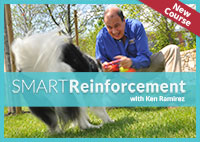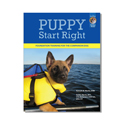A bonus, not a penalty
Many people refuse to crate or kennel-train their dogs because they feel the confinement is cruel. However, a crate or kennel can give dogs a sense of security. Crate training done properly is also a highly effective management system that can be a lifesaver for dog owners. Like any training method, crating can be abused, but using a crate for appropriate time periods is helpful with a variety of important goals, including house training, preventing destructive behavior, and teaching a dog to settle and relax.

If a dog is taught through positive reinforcement to love the crate, the crate becomes his own private and safe place, much like a bedroom for a child. The crate or kennel is somewhere the dog can go and not be bothered; it's a perfect destination when the dog is tired or nervous. Dogs have a natural instinct to be in a den. Many dogs take to a crate very easily.
Crate training provides a number of benefits to owners. A crate that is sized properly (read more about size below) encourages a dog's instinct not to mess where he sleeps, helping to teach the dog bladder and bowel control. This tendency to view the crate as a clean place is a huge benefit house training a new rescue dog or puppy, of course!
Using a crate prevents a dog or pup from getting into trouble when you can't supervise directly. Those times might include at night, when you are at work (provided the work day is not too long and the dog gets exercise before and after), when you are busy cooking, or any other time when your attention is elsewhere than directly on your dog.
Crate training also teaches puppies and excitable dogs to expect and enjoy some down time, and conditions relaxed behavior. Dogs and pups can be put into a crate with a yummy and safe chew or stuffed Kong to keep them secure, relaxed, and out of mischief for periods of time.
Choosing a crate: type, size, and location
There are several varieties of crates available. It can be a bit daunting to figure out the size and style to pick for your dog. The most common crate varieties are wire crates, plastic crates, and fabric crates.
Fabric crates are great for small dogs to travel in, for sporting events, or for camping. With a fabric crate, your dog must be well trained. Since fabric crates are not secure, they are not recommended for long-term confinement without supervision. The benefits of a fabric crate are that it is lightweight and that it folds flat for easy storage and travel.

Some crates double as furniture!
Probably the best bet for a pet's home crate is a plastic or wire crate. I favor wire crates, as they fold flat for storage and are more economical to purchase. Plastic crates are sturdier and often feel more secure for your dog, as the walls are mostly solid. However, there are very sturdy metal crates that can be purchased, and you can always cover a wire crate with a blanket if your dog needs more privacy. For an escape artist, either a plastic crate or a rugged (not collapsible) metal crate would be best. Both plastic and metal crates can be fortified using strategically placed zip ties. If you are looking for a crate that matches your decor, fashionable dog crate furniture combos that double as end tables are available!
Selecting the right size crate can be confusing. Some people are inclined to choose a large-sized crate to give the dog lots of room. If you pick a crate that is too large, your dog may use a portion of the crate as a toilet. Pick a crate that is just large enough for your dog to stand up, turn around, and lay down comfortably, at least until the dog is house trained. Most wire crates come with a divider to block off a portion of the crate in order to make it smaller. With a plastic crate, place a box in the back half of the crate to make the space smaller. With these adjustment tricks, you do not have to buy multiple crates as your puppy grows. When your dog is toilet trained but not mature enough to be left loose in the house, feel free to go with a larger crate so the dog really has room to stretch out.
I recommend placing the crate in an area of the house where both you and the dog can access it easily. The crate should be close enough to be handy, but out of the way enough that it is not going to be tripped over constantly. I usually place a crate right beside my bed; it helps teach puppies to sleep in the crate if you are right beside them and they don't feel so alone. I place another crate in a corner of my living room.
A positive place
It works best for a dog to be introduced to a crate gradually, rather than just plopping him in for the night or long periods. When your new dog or puppy first comes home, acclimate him to the crate by tossing a treat in, leaving the door open so that the dog can enter and exit freely. When your dog is comfortable going in and out of the crate, toss a treat inside and close the door for a second or two before letting the dog out.
Place a bed or mat that your dog already likes into the crate. This will help reduce any startling noises when the dog enters the crate. The dog will also be familiar with the bed, which could make him more willing to go into the crate. When you are not training, leave the crate open and place your dog's toy basket or favorite toys inside. Feed your dog meals in the crate, starting by leaving the door open and, as training progresses, closing it. If you give your dog any special treats, chewies, or bones, give them to him in the crate. A special bonus of having the mat in the crate is that the dog will begin to associate good things with the mat after being fed on it. Take the mat with you to the vet. Place it on the floor in the waiting room, on the scale, and in the exam room to help your dog become more comfortable and relaxed during vet visits.
Cue in and out
When the dog is going into the crate willingly, add a cue for entering the crate. Try "crate" or "bed" or "go in." Say your cue before tossing a treat inside. Soon your dog or puppy will be going into the crate on cue and eagerly.
Next, give the crate cue and wait for the puppy to go in on its own. Stop tossing the treat and wait for the puppy to enter. When the dog does go in, say "Yes!" or click a clicker and then feed the treat.
Start training a release cue at this time. The release cue tells your dog when he or she is free to leave the crate. This training step has the added benefit of encouraging and increasing self control. Your dog learns to remain calm and not rush out, even with the crate door wide open.
Cue the entrance, mark with yes or click, and treat. Almost immediately, say your release cue (try "ok," "free," "break," or "get out") and toss a treat on the floor outside of the crate. Keep tossing treats until the dog can leave the crate without seeing the treat; the dog exits just hearing the release cue. At that point, you can phase out the treat. Leaving the crate has become the reward.
Duration
If your dog is comfortable with the door closed for a few seconds, gradually increase the time the dog is in the crate. Remember to keep using a release cue to tell the dog that he can leave. If your dog does not have a problem remaining in the crate calmly for several minutes, start closing the door and ducking out of sight for a second before returning. Gradually build up the amount of time your dog is in the kennel. If the dog starts to whine, ignore him, letting the dog out once he is calm. If you want to leave your dog in the crate for longer periods, try putting a stuffed Kong, a bully stick, or a safe chewie into the crate as well.
All through this training process it is important to be patient and not to push your dog. Ask for what your dog is comfortable with rather than forcing your dog to do what you want. Crate training is best done in baby steps. If you can get your dog or puppy comfortable with the crate before the first night in it, your odds of getting a good sleep that night will be much higher. Once your dog is crate trained and house trained fully, you can leave the dog in a crate for up to 8 hours. The dog should have good exercise before and after, and should be left in the crate with something safe to occupy his attention. Your dog will likely spend most of the time sleeping!
Younger puppies cannot be left in a crate for as long as 8 hours. Physically, puppies cannot hold their bladders long enough, and it isn't fair to ask for that. A good general rule to follow is one hour in the crate for each month of age. A three-month-old puppy should be fine in the crate for three hours. Puppies should sleep in their crates at night, as this helps them learn to sleep through the night. Place the crate directly beside your bed in early first training so that your puppy will not feel lonely and frightened, and can wake you easily in the middle of the night for a bathroom break.
When a little extra is needed

Puppy relaxing on a soft blanket.
While some dogs take naturally to a crate, others are not as eager. If your dog whines, cries, and puts up a fuss that keeps you awake, it's easy to give in and let him out of the crate and into your bed to sleep. Therefore, it is essential that your dog or puppy never learns that whining, crying, and barking will get open the crate and earn an invitation to your bed. Be patient and consistent with the message that calm behavior is the key to being let out. Wait for even a few seconds of silence before opening the door.
Be strong and you will make it through the first few nights. Set up a puppy's crate with a hot water bottle and a blanket that has your scent on it. This will help the puppy feel more secure and will be reminiscent of sleeping close to his canine mom and littermates. Remember, your puppy has just been taken away from his family. Everything he knows has changed and he is likely frightened and confused.
Time-out
A crate can also be used as an effective and humane punishment. As long as the crate has lots of positive value built up, you can use it as an occasional time-out zone. If crate training is done properly, your pup will be conditioned to relax and settle inside the crate. Putting an unruly pup into a crate as a time-out for a few minutes teaches him to settle, and also removes all reinforcing stimulus for his "naughty" behavior. However, if you are resorting to putting your dog in time-out multiple times per day, you risk developing a negative association with the crate. The crate should be used in this way as a last resort, and only if redirecting to an appropriate behavior or ignoring the undesirable behavior does not work.
From the crate, onward
I have fostered and raised many puppies, and can't imagine doing it without creating a positive association with the crate. Within a very short time, most of the dogs that attend our dog daycare program enter their crates easily when we ask.
In addition to the value of a crate at home, having a crate-trained dog is wonderful when you are travelling, when your dog needs to go to the vet or groomer, or if you plan to compete in any dog sports. Trained properly with positive reinforcement and patience, the crate becomes a safe place for a dog. You will find that your dog uses the crate on his own when he is tired, and enters willingly and eagerly when asked. All it takes is an investment of time and a few treats to end up with a happy dog and a happy human!








Post new comment